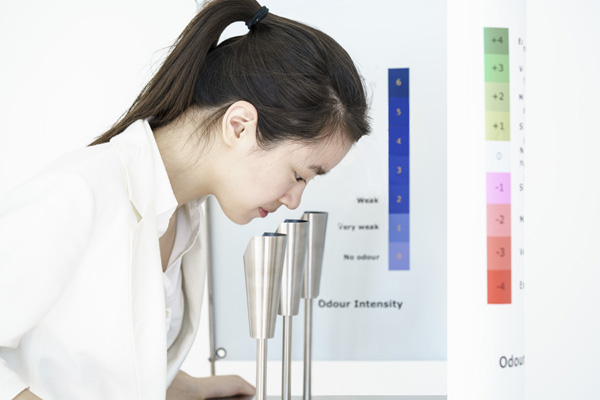Our sensory laboratory is among the best in the world
Our sensory laboratory houses the proprietary fourth generation dynamic olfactometer at our state-of-the-art odour testing room. Both our operator and odour panelists have over 20 years’ experience working in the field. We now offer comprehensive odour testing services including odour concentration, odour intensity, odour character and odour hedonic tone following the relevant Australian measurement standards and international standards.
All the odour tests are carried out using the DynaScent olfactometer. DynaScent not only presents the sample either diluted or undiluted but also collects the panellist’s responses in the database. The DynaScent operating software calculates the testing results and prints the testing reports.
- Odour samples tested for odour concentrations are presented in ascending order (physical concentrations) follows the Australian Standard (AS/NZS 4323:3- 2001: Stationary Source Emissions – Determination of Odour Concentration by Dynamic Olfactometry).
- Odour samples tested for odour-concentration intensity are presented in random order follows the Germany VDI guideline (VDI 3882.1, 1992-10, Olfactometry: Determination of Odour Intensity).
- Odour samples tested for odourich are presented “as it is” without dilution in compliance with AS/NZS 2542.2.3- 2014: Sensory analysis - Specific methods - Guidelines for the use of quantitative response scales (rating).
- Odour samples tested for difference/similarity (triangle test) are presented “as it is” without dilution at random order in compliance with AS/NZS 2542.2.2;- 2014, Sensory analysis - Specific methods - Triangle test.
Olfactometry is a psychophysical method based upon the olfactory responses of individuals. The large variation in individual sensory sensitivity among the population is no doubt a major source of experimental error. In the late 80's, developments in the methodology of olfactometry, particularly in dilution automation and panellist management, dramatically improved the repeatability and reproducibility of olfactometry measurements. As a result, the reproducibility between odour testing laboratories has been dropped from a factor of 40 down to 3 in European countries. At EnvironOdour, we can control the reproducibility to be less than a factor of 2.
With over 10 years’ experience in operating mass flow controller based olfactometer, it became clear that the one of the biggest source of error in odour measurement is the accuracy of the dilution ratio. The dilution ratio can sometime drift a factor of 2 - 4 over a period of 3 months due to contamination and clogging from the odour samples.
As mentioned above, it has been a long path for the odour measurement to gradually improve the measurement of accuracy and precision. At EnvironOdour, we have mainly focused on the improvement of olfactometry technique, panellist management and testing room.
Our distinct features separate us from the others:
- Regularly calibrated DynaScent digital olfactometer II
- 6 person panels with on-going performance monitoring
- For odour concentration measurement, triangle testing mode (three cups presentation), binary dilution mode (a dilution factor of two) over the wide dilution ranges of 2 to 262,000
- Small volume of odour samples required (about 2 litres)
- Extensive self-cleaning mechanism to flush the olfactometer between series and samples
- Automatic generated testing report
The introduction of the automatic calibration in the DynaScent olfactometer has made it possible to determine the odour intensity relationship and assess the ambient odour level. Now, EnvironOdour laboratory can evaluate all odour attributes: odour threshold, odour intensity, character and hedonic tone following the relevant measurement standards.


